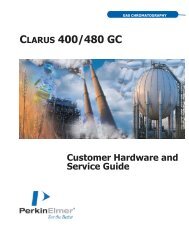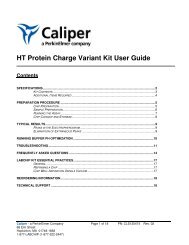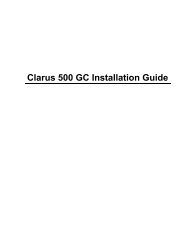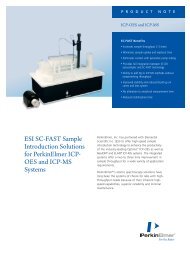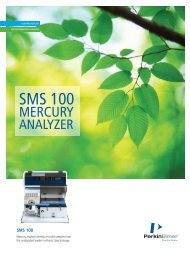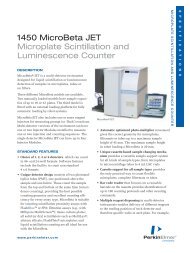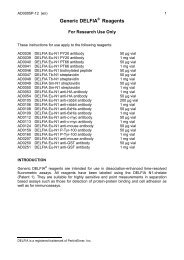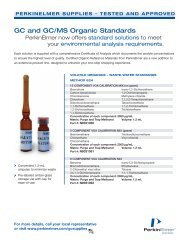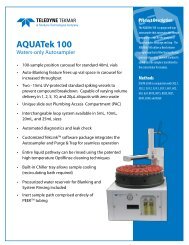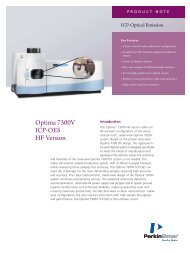Accurate. Brighter. Better. Distinctive Luminescence ... - PerkinElmer
Accurate. Brighter. Better. Distinctive Luminescence ... - PerkinElmer
Accurate. Brighter. Better. Distinctive Luminescence ... - PerkinElmer
You also want an ePaper? Increase the reach of your titles
YUMPU automatically turns print PDFs into web optimized ePapers that Google loves.
ACCURATE.<br />
BRIGHTER.<br />
BETTER.<br />
<strong>Distinctive</strong> <strong>Luminescence</strong><br />
Instruments and Reagents
Table of<br />
Contents<br />
LUMINESCENcE ASSAY SYSTEMS AND INSTRUMENTS ................................................ 1<br />
reporter gene assays<br />
neolite.......................................................................................................................... 2<br />
britelite plus and steadylite plus............................................................................... 3<br />
ATP QUANTIFICATION<br />
ATPlite ® cytotoxicity and cell proliferation assays............................................................ 5<br />
Calcium flux assay systems<br />
AequoScreen ® and PhotoScreen ® assays......................................................................... 7<br />
Calcium DETECTION<br />
AequoZen ® ready-to-use frozen cells.............................................................................. 8<br />
CELL LINES<br />
Ordering Information...................................................................................................... 9<br />
Detection instrumentation and automation<br />
EnSpire Multilabel Plate Reader with Ultra-sensitive <strong>Luminescence</strong>........................... 12<br />
VICTOR Plate Readers................................................................................................ 12<br />
EnVision ® Multilabel Readers......................................................................................... 12<br />
MicroBeta 2® and TopCount ® Plate Counters................................................................. 13<br />
ViewLux Imagers........................................................................................................ 13<br />
JANUS ® Automated Workstation.................................................................................. 13<br />
INSTRUMENT QUICK REFERENCE GUIDE .............................................. 14<br />
Microplates for <strong>Luminescence</strong> Assays............................................................................ 16
PLATFORM<br />
Overview<br />
STREAMLINED DETECTION.<br />
SIMPLY BRILLIANT.<br />
<strong>Luminescence</strong> detection platforms provide simple and reproducible<br />
results over a wide dynamic range offering great value for many<br />
research and discovery applications. Choose from a variety of<br />
assay systems and instruments to optimally streamline your<br />
detection needs.<br />
Key Benefits<br />
<strong>Luminescence</strong> detection:<br />
• Cost-effective<br />
• Easy set-up for high throughput<br />
• Rapid – miniaturizable and automatable; some systems<br />
allow results in 15-25 minutes<br />
• No separation steps (homogeneous assays)<br />
• Sensitive – better than fluorescence technologies<br />
• Less interference<br />
<strong>Luminescence</strong> Assay Systems and instruments<br />
AequoScreen<br />
AequoZen<br />
PhotoScreen<br />
britelite plus steadylite plus neolite<br />
ATPlite 1step<br />
A T Plite<br />
Applications • Calcium Flux • Reporter • Reporter • Reporter • Cytotoxicity • Cytotoxicity<br />
• GPCR Gene Assay Gene Assay Gene Assay • Cell Proliferation • Cell Proliferation<br />
• Ion Channels • GPCR • GPCR • GPCR Assay Assay<br />
Half-life (hours) Flash 0.5 4 to 5 2.5 0.5 5<br />
Sensitivity High Very High Moderate High As few as As few as<br />
5 cells/well 5 cells/well<br />
Plate Format 96 96 96 96 96 96<br />
(wells) 384 384 384 384 384 384<br />
1536 1536 1536 1536 1536 1536<br />
Instrumentation — TopCount TopCount TopCount TopCount TopCount<br />
MicroBeta 2 MicroBeta 2 MicroBeta 2 MicroBeta 2 MicroBeta 2 MicroBeta 2<br />
LumiJET EnSpire EnSpire EnSpire EnSpire EnSpire<br />
EnVision EnVision EnVision EnVision EnVision EnVision<br />
VICTOR X VICTOR X VICTOR X VICTOR X VICTOR X VICTOR X<br />
VICTOR X Light VICTOR X Light VICTOR X Light VICTOR X Light VICTOR X Light VICTOR X Light<br />
— ViewLux ViewLux ViewLux ViewLux ViewLux<br />
www.perkinelmer.com/brightercelllines<br />
1
Reporter Gene<br />
Assays<br />
Intensity. Flexibility.<br />
JUST RIGHT FOR<br />
EVERY ASSAY.<br />
Whether your assay requires<br />
the sensitivity provided by<br />
high signal intensity, or the<br />
flexibility of an extended<br />
signal half-life, <strong>PerkinElmer</strong><br />
provides a solution. Choose from one of three<br />
luciferase detection systems: neolite, britelite plus,<br />
or steadylite plus depending on the specific requirements<br />
of your experiment.<br />
Key Benefits<br />
• No more washing – just add your lites reagent<br />
of choice, mix, incubate, and read<br />
• Hassle-free storage – all lites reagents are<br />
designed for extended storage at 2-8 °C<br />
(no -20 °C storage required)<br />
• Odor-friendly, eliminates hood work – lites<br />
products do not contain DTT and do not have<br />
the hazards and repugnant odor typical of<br />
conventional luciferase detection systems<br />
• Excellent Z’ values – superior S/B ratios allow for<br />
excellent Z’ values in antagonist and agonist studies<br />
neolite — Bright and Stable<br />
neolite offers the ultimate compromise between strong signal<br />
intensity and extended signal half-life. It provides a minimum<br />
half-life of 2.5 hours while maintaining excellent sensitivity.<br />
neolite also delivers superior reproducibility, as it has less sensitive<br />
mixing conditions than typical luminescent detection systems. It<br />
is ideal for medium to high throughput applications which employ<br />
batch processing methods but still require exceptional sensitivity.<br />
Reporter Gene Assay Principle<br />
Experimental<br />
+ + Treatment<br />
Luciferase +<br />
Detection Reagents<br />
O 2<br />
ATP<br />
DNA-encoded<br />
plasmid<br />
CO 2<br />
AMP + P i<br />
Reporter gene assays utilizing the luciferase gene, derived<br />
from the North American firefly Photinus pyralis, have long<br />
been used as a sensitive method to monitor changes in<br />
gene expression. Firefly luciferase catalyzes the oxidation of<br />
the substrate luciferin to produce light, allowing direct<br />
measurement of luciferase activity levels via luminescent<br />
detection. Thus, expression levels of a gene of interest can be<br />
tracked through creation of a recombinant gene fusion with<br />
luciferase and subsequent quantitation of luciferase activity.<br />
Light<br />
2
steadylite plus — Long-lived Glow<br />
steadylite plus was developed to provide an extended signal<br />
half-life of up to 5 hours. This extended half-life makes<br />
steadylite plus the reagent of choice for high throughput<br />
screening where you require the same steady signal first plate<br />
in to last plate out.<br />
britelite plus — Intensively Sensitive<br />
britelite plus possesses an extremely strong signal intensity.<br />
With a signal half-life of 30 minutes, it is ideal for assays<br />
requiring the utmost sensitivity and for any application<br />
employing continuous processing methodology.<br />
See Applications Table on page 4.<br />
High performance sub-femtomole detection<br />
10 7<br />
10 6<br />
steadylite plus<br />
10 -17 10 -16 10 -15 10 -14 10 -13 10 -12 10 -11 10 -10 10 -9<br />
Counts Per Second<br />
10 5<br />
10 4<br />
10 3<br />
10 2<br />
10 1<br />
britelite plus<br />
neolite<br />
[Luciferase] (gram)<br />
A dilution series of luciferase enzyme where luciferase, britelite plus and neolite have<br />
a sub-femtomole detection limit for luciferase compared to steadylite plus.<br />
<strong>Luminescence</strong> for 10 -10 g luciferase per well<br />
7,000,000<br />
EnSpire multilabel plate reader with<br />
ultra-sensitive luminescence requires<br />
fewer cells to get the same signal<br />
as standard luminescence saving on<br />
expensive transfection reagent and<br />
substrate costs.<br />
<strong>Luminescence</strong> (RLU)<br />
6,000,000<br />
5,000,000<br />
4,000,000<br />
3,000,000<br />
2,000,000<br />
1,000,000<br />
0<br />
0 50 100 150 200 250 300 350<br />
Time (min)<br />
britelite plus<br />
neolite<br />
steadylite plus<br />
Time course of the luminescent signal of britelite plus, neolite and steadylite plus<br />
where britelite plus shows an intense signal with rapid decrease in signal and neolite<br />
and steadylite plus both show strong signal intensity over an extended period of time.<br />
www.perkinelmer.com/brightercelllines<br />
3
The <strong>PerkinElmer</strong> suite of luciferase detection systems brings the<br />
simplicity of reporter gene assays to a whole new level. All lites<br />
products offer superior performance, while still providing convenient<br />
one-step processing and ease of storage and handling.<br />
neolite<br />
steadylite plus<br />
britelite plus<br />
Sensitivity High Moderate Very High<br />
Half-life (hours) 2.5 5 0.5<br />
Plate Format 96, 384, 1536 96, 384, 1536 96, 384, 1536<br />
Applications • Low transfection efficiencies • Strong steady signal • Superior sensitivity<br />
• Primary cell transfection • Extended read time • Low transfection efficiencies<br />
• Increased assay windows • High throughput screening • Stem cell transfection<br />
• Extended read times • Extended batch processing • Rapid read time –<br />
• Batch processing<br />
continuous processing<br />
Part Number Volume (mL) Data Points*<br />
neolite<br />
steadylite plus<br />
britelite plus<br />
in 96-, 384- and 1536-well microplates<br />
6016716 6016756 6016766 10 100, 400, 3300<br />
6016711 6016751 6016761 100 1000, 4000, 33000<br />
6016767 6016757 6016767 500 5000, 20000, 165000<br />
6016769 6016759 6016769 1000 10000, 40000, 330000<br />
* The recommended assay volumes are 100 µL for 96-well microplates, 25 µL for 384-well microplates and 3 µL for 1536-well microplates.<br />
CHO β 2<br />
AR Agonist curves<br />
CHO β 2<br />
AR Antagonist curves<br />
<strong>Luminescence</strong> (CPS)<br />
9,000,000<br />
8,000,000<br />
7,000,000<br />
6,000,000<br />
5,000,000<br />
4,000,000<br />
3,000,000<br />
2,000,000<br />
1,000,000<br />
0<br />
-∞<br />
-12 -11 -10 -9 -8 -7 -6<br />
Log [isoproterenol] (M)<br />
britelite plus<br />
EC 50<br />
: 0.18 nM; S/B: 24<br />
neolite<br />
EC 50<br />
: 0.12 nM; S/B: 24<br />
steadylite plus<br />
EC 50<br />
: 0.10 nM; S/B: 21<br />
<strong>Luminescence</strong> (CPS)<br />
7,000,000<br />
6,000,000<br />
5,000,000<br />
4,000,000<br />
3,000,000<br />
2,000,000<br />
1,000,000<br />
0<br />
-∞<br />
-12 -11 -10 -9 -8 -7 -6<br />
Log [ICI 118,551] (M)<br />
britelite plus<br />
IC 50<br />
: 0.80 nM; S/B: 12<br />
neolite<br />
IC 50<br />
: 0.15 nM; S/B: 15<br />
steadylite plus<br />
IC 50<br />
: 0.16 nM; S/B: 17<br />
CHO β 2<br />
AR Agonist curves<br />
CHO β 2<br />
AR Antagonist curves<br />
<strong>Luminescence</strong> (CPS)<br />
1,750,000<br />
1,500,000<br />
1,250,000<br />
1,000,000<br />
750,000<br />
500,000<br />
250,000<br />
neolite<br />
EC 50<br />
: 0.12 nM; S/B: 24<br />
steadylite plus<br />
EC 50<br />
: 0.10 nM; S/B: 21<br />
<strong>Luminescence</strong> (CPS)<br />
800,000<br />
600,000<br />
400,000<br />
200,000<br />
neolite<br />
IC 50<br />
: 0.15 nM; S/B: 15<br />
steadylite plus<br />
IC 50<br />
: 0.16 nM; S/B: 17<br />
0<br />
-∞<br />
-12 -11 -10 -9 -8 -7 -6<br />
Log [isoproterenol] (M)<br />
0<br />
-∞<br />
-12 -11 -10 -9 -8 -7 -6<br />
Log [ICI 118,551] (M)<br />
Agonist and antagonist dose-response curves comparing britelite plus, neolite and steadylite plus.<br />
4
ATP<br />
Quantification<br />
Light Up<br />
The ATP LEVELS<br />
AT YOUR PACE.<br />
Fast, reliable detection of ATP<br />
for cell quantification<br />
ATPlite 1step and ATPlite are patented 1<br />
innovative technologies that measure<br />
cell proliferation and cytotoxicity<br />
in mammalian cells based on the<br />
detection of ATP using firefly luciferase. Light<br />
production caused by the reaction of ATP with<br />
added luciferase and D-luciferin is proportional<br />
to the ATP concentration.<br />
ATP is a marker for cell viability because it is<br />
present in all metabolically active cells. Because<br />
ATP concentration declines rapidly when cells<br />
undergo necrosis or apoptosis, monitoring ATP<br />
is a good indicator of cytocidal, cytostatic, and<br />
proliferation effects.<br />
Key Benefits<br />
ATPlite 1step – Highest Sensitivity<br />
• True “mix and measure” continuous processing<br />
• Ultra high sensitivity, 3 times more light output<br />
than ATPlite<br />
• Short equilibrium time for faster processing<br />
• Signal half-life of 30 minutes<br />
ATPlite – Convenient, Extended Signal<br />
• 2-step format, non-separation assay for time<br />
course studies; lysate can be stored frozen and<br />
tested later<br />
• Quantitate from
HTS FOR<br />
CALCIUM FLUX<br />
ROBUST ASSAYS<br />
FOR CALCIUM FLUX<br />
IN A FLASH.<br />
AequoScreen Aequorin and PhotoScreen Photina photoproteins are derived from the<br />
jellyfish Aequoria victoria and Obelia longissima respectively. Upon calcium binding,<br />
the photoprotein oxidizes coelenterazine into coelenteramide with the production of CO 2<br />
and emission of light. Because both can reduce costs and increase productivity, they<br />
are ideal replacement technologies for standard fluorescent dyes.<br />
KEY BENEFITS:<br />
Photoprotein technology:<br />
• Fully automatable – can be miniaturized to 1536 format<br />
• Reduces reagent and consumable costs, including the<br />
number of cells required for an assay<br />
• Allows accurate detection of agonists, antagonists, partial<br />
agonists, and allosteric modulators through high signal-tonoise<br />
background ratio<br />
• Delivers robust assay (high Z’, low CV values)<br />
• Offers powerful tools to convert mammalian cell lines<br />
already expressing a GPCR to a luminescence assay format<br />
• Reduces false positives from auto-fluorescent compounds<br />
in screening libraries<br />
• Increases throughput using option to work with cells<br />
in suspension<br />
• Achieves efficient, high throughput – over 200,000<br />
data points/day (depending on assay instrument and<br />
microplate format)<br />
The ideal calcium flux assay for GPCR analysis — AequoScreen<br />
AequoScreen is a generic GPCR technology, which can be<br />
used with dedicated flash luminescence instrumentation<br />
(MicroBeta 2 LumiJET, VICTOR, EnVision, FLIPR ®TETRA , FLIPR ®TETRA<br />
(aequorin option) FDSS) to measure calcium from G q<br />
-coupled<br />
receptors or G s<br />
-, G i<br />
-coupled receptors through a promiscuous<br />
or chimeric G-protein.<br />
Cumulative response (CCPS)<br />
15,000,000<br />
10,000,000<br />
5,000,000<br />
0<br />
CHO-H 1<br />
cell line<br />
Histamine<br />
trans -triprolidine<br />
-12 -11 -10 -9 -8 -7 -6 -5<br />
Log [agonist/antagonist] (M)<br />
agonist<br />
Z’ = 0.60<br />
pEC 50<br />
= 7.61<br />
antagonist<br />
Z’ = 0.75<br />
pIC 50<br />
= 8.24<br />
Emitted Light (AUC, RLU)<br />
75,000<br />
70,000<br />
65,000<br />
60,000<br />
55,000<br />
50,000<br />
45,000<br />
40,000<br />
35,000<br />
30,000<br />
25,000<br />
20,000<br />
15,000<br />
10,000<br />
5,000<br />
CHO-H 1<br />
cell line<br />
0<br />
1e-5 0.0001 0.001 0.01 0.1 1 10 100 1000<br />
[Histamine] (µM)<br />
Z’ = 0.70 +/- 0.19<br />
pEC 50<br />
= 7.54 +/- 0.10<br />
Histamine H 1<br />
AequoScreen cell line agonist and antagonist suspension assay dose<br />
response curves demonstrate the quality of data produced by the MicroBeta 2<br />
LumiJET. Histamine H 1<br />
AequoScreen cells (5000 cells) were dispensed together<br />
with buffer or antagonist (trans-triprolidine, final concentration 10 x IC 50<br />
) into<br />
an OptiPlate-384 in 36 replicates. The agonist (histamine, final concentration<br />
10 x EC 50<br />
), was dispensed and resulting luminescence was recorded using the<br />
MicroBeta 2 LumiJET (total volume, 70 µl).<br />
Histamine dose response curve, 1536-well suspension assay, 1500 cells/well<br />
(mean +/- SD from 32 wells) run on a LumiLux ® , demonstrating that the aequorin<br />
technology can be miniaturized.<br />
6
CHO-Adenosine A 3<br />
PhotoScreen cell line<br />
The AequoScreen platform includes:<br />
• Parental cell lines expressing mitochondrially targeted<br />
apoaequorin with or without the promiscuous<br />
G-protein Ga 16<br />
• Double transfected cell lines expressing mitochondrially<br />
targeted apoaequorin and GPCR with or without the<br />
promiscuous G-protein Ga 16<br />
• AequoZen frozen ready-to-use cells: growth arrested<br />
double transfected cell lines available frozen for immediate<br />
use (see next page)<br />
• Aequorin plasmids expressing mitochondrially targeted<br />
apoaequorin protein under the control of the CMV promoter,<br />
with or without the promiscuous G-protein Ga 16<br />
• Fully validated Starter Kits for AequoScreen cell lines<br />
and AequoZen ready-to-use cells enabling you to become<br />
familiar with the AequoScreen technology<br />
PhotoScreen — a novel assay for calcium coupled ion<br />
channel analysis<br />
Photina is a chimeric photoprotein, generated from obelin<br />
and clytin, which can be used to measure calcium from<br />
G i<br />
-, G q<br />
-, and G s<br />
- coupled receptors as well as calcium-coupled<br />
ion channels and transporters. Photina light emission can<br />
also be measured using flash luminescence instrumentation.<br />
The PhotoScreen platform includes:<br />
• Double transfected cell lines expressing mitochondrially<br />
targeted apophotoprotein and a recombinant calcium<br />
coupled ion channel/transporter or a recombinant<br />
GPCR with or without the G qi3<br />
• Fully Validated Cell Line Starter Kit<br />
Emitted Light (AUC, RLU)<br />
IB-MECA (M)<br />
5,000 c/w 10,000 c/w 15,000 c/w<br />
EC 50<br />
(M) 3.8e-009 6.6e-009 3.3e-009<br />
IB-MECA agonist 384-well adherent assay, cell density study. (Mean +/- SD 8 wells)<br />
run on a FLIPR ®tetra .<br />
Cumulative response (CCPS)<br />
The Muscarinic M 5<br />
AequoScreen cell line agonist (Acetylcholine) and antagonist<br />
(N-Me-Scopolamine) dose response curves run on a MicroBeta 2 LumiJET. 384-well<br />
format, 6,000 cells/well.<br />
Emitted Light (AUC, RLU)<br />
25,000<br />
20,000<br />
15,000<br />
10,000<br />
5,000<br />
1,000,000<br />
750,000<br />
500,000<br />
250,000<br />
0<br />
10 -13 10 -12 10 -11 10 -10 10 -9 10 -8 10 -7 10 -6 10 -5<br />
0<br />
CHO-M 5<br />
cell line<br />
Acetylcholine<br />
N-Me-Scopolamine<br />
-12 -11 -10 -9 -8 -7 -6 -5<br />
Log [agonist/antagonist] (M)<br />
HEK PhotoScreen/hTRPA1<br />
350,000<br />
300,000<br />
250,000<br />
200,000<br />
150,000<br />
100,000<br />
50,000<br />
0<br />
10 -9 10 -8 10 -7 10 -6 10 -5 10 -4 10 -3 10 -2<br />
agonist<br />
Z’ = 0.53<br />
pEC 50<br />
= 7.72<br />
antagonist<br />
Z’ = 0.72<br />
pIC 50<br />
= 9.1<br />
[AITC] (M)<br />
10,000 c/w 15,000 c/w 20,000 c/w<br />
EC 50<br />
(M) 3.4e-5 3.6e-5 3.7e-5<br />
384-well suspension assay, cell density study, (Mean +/- SD 8 wells) run on a LumiLux.<br />
www.perkinelmer.com/brightercelllines<br />
7
CELL LINE – frozen cells<br />
CALCIUM detection<br />
FULLY VALIDATED FROZEN CELLS<br />
OFF THE SHELF<br />
OR CUSTOM-MADE<br />
AequoZen frozen cells, pre-validated for aequorin calcium detection, enable<br />
rapid and cost-effective GPCR profiling, pharmacology or<br />
screening applications.<br />
KEY BENEFITS<br />
• Available off-the-shelf or customized to your needs<br />
• Simple step-by-step protocols for cell culture functional testing<br />
• Affordable access to small aliquots of cells (10 x 10 6 cells)<br />
• Highest quality, growth-arrested gamma irradiated cells to<br />
minimize biological variation<br />
• Versatile up-scaling to suit specific needs<br />
Ready-to-use cells take the stress out of functional testing<br />
We remove the lengthy cell culture process from your functional<br />
testing; we culture the cells, freeze them with an optimized<br />
protocol, and gamma irradiate them to stop replication. These<br />
cells are then stored in liquid nitrogen or at -80 °C. Simply thaw<br />
them and use in your functional, cellular GPCR test.<br />
Convenient flexibility<br />
Frozen cells are available off-the-shelf in aliquots of 10 million<br />
cells per vial only for catalog products. Other sizes are offered<br />
for custom service only. We also scale-up to provide you with<br />
validated cells for full screening campaigns. Whether it is for<br />
screening, lead optimization or profiling, you can now perform<br />
cellular GPCR tests immediately by using batches of frozen cells<br />
on multiple receptors at a time. Users have the option to work<br />
in both suspension and adherent mode.<br />
Quality you can trust<br />
Our frozen cell portfolio undergoes a rigorous QC procedure;<br />
this procedure does not leave any trace of hazardous chemicals<br />
in the cell media and has been titrated to preserve functional<br />
response.<br />
Confident validation<br />
We validate defined families of GPCRs that let you perform<br />
selectivity studies rapidly and cost-effectively as needed.<br />
Validated batches give results meeting our QC criteria, both<br />
on agonist EC 50<br />
and signal window, so you can obtain the<br />
same reliable results with every purchase, every time.<br />
Frozen Cell, Log EC 50<br />
(M)<br />
-6<br />
-7<br />
-8<br />
-9<br />
-10<br />
Calcium Aequorin assay AT 1<br />
Cell Line vs. Frozen Cells for AT 1<br />
-11<br />
-11 -10 -9 -8 -7 -6<br />
Cell in culture, Log EC 50<br />
(M)<br />
r 2 = 0.95<br />
slope : 0.93<br />
AUC (LCPS)<br />
550<br />
500<br />
450<br />
400<br />
350<br />
300<br />
250<br />
200<br />
150<br />
100<br />
50<br />
0<br />
Background<br />
ATP Digitonin<br />
-13 -12 -11 -10 -9 -8 -7 -6 -5<br />
Log [angiotensin II] (M)<br />
Frozen<br />
In culture<br />
Cells in Culture<br />
Frozen Cells<br />
EC 50<br />
(M) 4.30 5.09<br />
8<br />
All batches are tested for quality of assay window and consistency of EC 50<br />
values. The calcium aequorin assay (left) illustrates the correlation between EC 50<br />
values of the<br />
reference agonist obtained on fresh versus frozen cells with an aequorin readout on 15 receptors. The AT 1<br />
pharmacology comparison values (right) are similar between<br />
fresh AequoScreen AT 1<br />
cell line kept in continuous culture and equivalent frozen cells.
cell line and frozen cell<br />
product listing<br />
ORDERING INFORMATION<br />
If you do not see the target you are interested in, please inquire as we are continuously expanding our portfolio and also provide custom cell line development.<br />
STARTER KITS<br />
Product Receptor Type Cat. No.<br />
AequoScreen starter kit H 1<br />
and M s<br />
AequoScreen Cell Line ES-001-A<br />
AequoZen starter kit H 1<br />
and M s<br />
AequoZen Frozen Cells ES-001-AF<br />
PhotoScreen starter kit A 3<br />
PhotoScreen Cell Line AX-001-PCF<br />
GPCR CELL LINES<br />
Receptor type Subtype product Type Cat. No.<br />
5-Hydroxytryptamine 5-HT 1A<br />
AequoScreen Cell Line ES-310-A<br />
5-HT 1A<br />
AequoZen Frozen Cells ES-310-AF<br />
5-HT 2A<br />
AequoScreen Cell Line ES-313-A<br />
5-HT 2A<br />
AequoZen Frozen Cells ES-313-AF<br />
5-HT 2B<br />
AequoScreen Cell Line ES-314-A<br />
5-HT 2C<br />
edited isoform AequoScreen Cell Line ES-315-A<br />
5-HT 2C<br />
edited isoform AequoZen Frozen Cells ES-315-AF<br />
5-HT 2C<br />
non edited isoform AequoScreen Cell Line ES-318-A<br />
5-HT 2C<br />
non edited isoform AequoZen Frozen Cells ES-318-AF<br />
5-HT 3A<br />
AequoScreen Cell Line ES-402-A<br />
5-HT 3A<br />
AequoZen Frozen Cells ES-402-AF<br />
5-HT 5A<br />
AequoScreen Cell Line ES-401-A<br />
5-HT 5A<br />
AequoZen Frozen Cells ES-401-AF<br />
5-HT 6<br />
AequoScreen Cell Line ES-316-A<br />
5-HT 7<br />
AequoZen Frozen Cells ES-316-AF<br />
Acetylcholine<br />
(Muscarinic) M 1<br />
AequoScreen Cell Line ES-210-A<br />
M 1<br />
AequoZen Frozen Cells ES-210-AF<br />
M 2<br />
AequoScreen Cell Line ES-211-A<br />
M 2<br />
AequoZen Frozen Cells ES-211-AF<br />
M 3<br />
AequoScreen Cell Line ES-212-A<br />
M 3<br />
AequoZen Frozen Cells ES-212-AF<br />
M 4<br />
AequoScreen Cell Line ES-213-A<br />
M 4<br />
AequoZen Frozen Cells ES-213-AF<br />
M 5<br />
AequoScreen Cell Line ES-214-A<br />
M 5<br />
AequoZen Frozen Cells ES-214-AF<br />
Adenosine A 1<br />
AequoScreen Cell Line ES-010-A<br />
A 1<br />
AequoZen Frozen Cells ES-010-AF<br />
Receptor type Subtype product Type Cat. No.<br />
A 2A<br />
AequoScreen Cell Line ES-011-A<br />
A 2A<br />
AequoZen Frozen Cells ES-011-AF<br />
A 2B<br />
AequoScreen Cell Line ES-013-A<br />
A 3<br />
AequoScreen Cell Line ES-012-A<br />
A 3<br />
AequoZen Frozen Cells ES-012-AF<br />
A 3<br />
PhotoScreen Cell Line AX-001-PCF<br />
Adrenoceptors alpha 1A<br />
AequoScreen Cell Line ES-036-A<br />
alpha 1A<br />
AequoZen Frozen Cells ES-036-AF<br />
alpha 1B<br />
AequoScreen Cell Line ES-037-A<br />
alpha 1D<br />
AequoScreen Cell Line ES-038-A<br />
alpha2 A<br />
AequoZen Frozen Cells ES-030-AF<br />
alpha 2A<br />
AequoScreen Cell Line ES-030-A<br />
alpha 2B<br />
AequoScreen Cell Line ES-031-A<br />
alpha 2B<br />
AequoZen Frozen Cells ES-031-AF<br />
alpha 2C<br />
AequoScreen Cell Line ES-032-A<br />
beta 1<br />
AequoScreen Cell Line ES-033-A<br />
beta 1<br />
AequoZen Frozen Cells ES-033-AF<br />
Anaphylatoxin C3a AequoScreen Cell Line ES-730-A<br />
C5a AequoScreen Cell Line ES-731-A<br />
C5a AequoZen Frozen Cells ES-731-AF<br />
Angiotensin AT 1<br />
AequoScreen Cell Line ES-072-A<br />
AT 1<br />
AequoZen Frozen Cells ES-072-AF<br />
Apelin APJ AequoScreen Cell Line ES-460-A<br />
Beta Alanine MRGPRD, TGR7 AequoScreen Cell Line ES-741-A<br />
Bombesin BB 1<br />
AequoScreen Cell Line ES-581-A<br />
BB 2<br />
AequoScreen Cell Line ES-582-A<br />
BB 3<br />
AequoScreen Cell Line ES-580-A<br />
Bradykinin B 1<br />
AequoScreen Cell Line ES-091-A<br />
B 1<br />
(rat) AequoScreen Cell Line ES-092-A<br />
B 2<br />
AequoScreen Cell Line ES-090-A<br />
Calcitonin AM 2<br />
AequoScreen Cell Line ES-430-A<br />
CGRP 1<br />
AequoScreen Cell Line ES-420-A<br />
CGRP 1<br />
AequoZen Frozen Cells ES-420-AF<br />
Cannabinoid CB 1<br />
AequoScreen Cell Line ES-110-A<br />
CB 1<br />
AequoZen Frozen Cells ES-110-AF<br />
Chemerin GPR1 AequoScreen Cell Line ES-661-A<br />
www.perkinelmer.com/brightercelllines<br />
9
Receptor type Subtype product Type Cat. No.<br />
Chemerin GPR1 AequoZen Frozen Cells ES-661-AF<br />
Chemokine CCR10 AequoScreen Cell Line ES-143-A<br />
CCR10 AequoZen Frozen Cells ES-143-AF<br />
CCR2b AequoScreen Cell Line ES-133-A<br />
CCR2b AequoZen Frozen Cells ES-133-AF<br />
CCR3 AequoScreen Cell Line ES-138-A<br />
CCR3 AequoZen Frozen Cells ES-138-AF<br />
CCR6 AequoScreen Cell Line ES-139-A<br />
CCR6 AequoZen Frozen Cells ES-139-AF<br />
CCR7 AequoScreen Cell Line ES-140-A<br />
CCR7 AequoZen Frozen Cells ES-140-AF<br />
CCR8 AequoScreen Cell Line ES-136-A<br />
CCR8 AequoZen Frozen Cells ES-136-AF<br />
CCR9a AequoScreen Cell Line ES-146-A<br />
CCR9a AequoZen Frozen Cells ES-146-AF<br />
CX 3<br />
CR1 AequoScreen Cell Line ES-137-A<br />
CX 3<br />
CR1 AequoZen Frozen Cells ES-137-AF<br />
CXCR2 AequoScreen Cell Line ES-145-A<br />
CXCR2 AequoZen Frozen Cells ES-145-AF<br />
CXCR3 AequoScreen Cell Line ES-142-A<br />
CXCR3 AequoZen Frozen Cells ES-142-AF<br />
CXCR6 AequoScreen Cell Line ES-720-A<br />
CXCR6 AequoZen Frozen Cells ES-720-AF<br />
XCR1 AequoScreen Cell Line ES-148-A<br />
XCR1 AequoZen Frozen Cells ES-148-AF<br />
CCR1 AequoScreen Cell Line ES-132-A<br />
Cholecystokinin CCK 1<br />
AequoScreen Cell Line ES-530-A<br />
CCK 1<br />
AequoZen Frozen Cells ES-530-AF<br />
CCK 2<br />
AequoScreen Cell Line ES-531-A<br />
CCK 2<br />
AequoZen Frozen Cells ES-531-AF<br />
Corticotropin-Releasing<br />
Factor CRF 1<br />
AequoScreen Cell Line ES-152-A<br />
Dopamine D 2L<br />
AequoScreen Cell Line ES-171-A<br />
D 2L<br />
AequoZen Frozen Cells ES-171-AF<br />
Endothelin ET A<br />
AequoScreen Cell Line ES-320-A<br />
ET A<br />
AequoZen Frozen Cells ES-320-AF<br />
ET B<br />
AequoScreen Cell Line ES-321-A<br />
ET B<br />
AequoZen Frozen Cells ES-321-AF<br />
Formyl Peptide FPRL1 AequoScreen Cell Line ES-610-A<br />
Free Fatty Acid FFA1 (GPR40) AequoScreen Cell Line ES-652-A<br />
FFA1 (GPR40) AequoZen Frozen Cells ES-652-AF<br />
GPR120 AequoScreen Cell Line ES-800-A<br />
GPR120 AequoZen Frozen Cells ES-800-AF<br />
Receptor type Subtype product Type Cat. No.<br />
GABA B<br />
GABA B1a/B2<br />
AequoScreen Cell Line ES-500-A<br />
Galanin GAL 1<br />
AequoScreen Cell Line ES-510-A<br />
GAL 2<br />
AequoScreen Cell Line ES-511-A<br />
GAL 2<br />
AequoZen Frozen Cells ES-511-AF<br />
GAL 2<br />
PhotoScreen Cell Line AX-008-PCF<br />
Ghrelin ghrelin AequoScreen Cell Line ES-410-A<br />
ghrelin AequoZen Frozen Cells ES-410-AF<br />
Glucagon glucagon AequoScreen Cell Line ES-710-A<br />
Secretin AequoScreen Cell Line ES-712-A<br />
Secretin AequoZen Frozen Cells ES-712-AF<br />
Glycoprotein Hormone TSH AequoScreen Cell Line ES-790-A<br />
Gonadotropin-Releasing<br />
Hormone GnRH AequoScreen Cell Line ES-600-A<br />
Histamine H 1<br />
AequoScreen Cell Line ES-390-A<br />
H 1<br />
AequoZen Frozen Cells ES-390-AF<br />
H 2<br />
AequoScreen Cell Line ES-391-A<br />
H 2<br />
AequoZen Frozen Cells ES-391-AF<br />
H 3<br />
AequoScreen Cell Line ES-392-A<br />
H 3<br />
AequoZen Frozen Cells ES-392-AF<br />
H 4<br />
AequoScreen Cell Line ES-393-A<br />
H 4<br />
AequoZen Frozen Cells ES-393-AF<br />
KiSS1 (Metastin) KISS1 (GPR54) AequoScreen Cell Line ES-630-A<br />
Leukotriene BLT 1<br />
(LTB4R1) AequoScreen Cell Line ES-340-A<br />
CysLT1 AequoScreen Cell Line ES-470-A<br />
OXE (HM74-like) AequoScreen Cell Line ES-640-A<br />
Lysophospholipid S 1<br />
P 2<br />
(EDG5) AequoScreen Cell Line ES-594-A<br />
S 1<br />
P 2<br />
(EDG5) AequoZen Frozen Cells ES-594-AF<br />
S 1<br />
P 4<br />
(EDG6) AequoScreen Cell Line ES-592-A<br />
S 1<br />
P 4<br />
(EDG6) AequoZen Frozen Cells ES-592-AF<br />
S 1<br />
P 5<br />
(EDG8) AequoScreen Cell Line ES-593-A<br />
S 1<br />
P 5<br />
(EDG8) AequoZen Frozen Cells ES-593-AF<br />
Mas related MrgX1 AequoScreen Cell Line ES-740-A<br />
MrgX2 AequoScreen Cell Line ES-742-A<br />
Melanin-Concentrating<br />
Hormone MCH 1<br />
AequoScreen Cell Line ES-370-A<br />
MCH 1<br />
AequoZen Frozen Cells ES-370-AF<br />
MCH 2<br />
AequoScreen Cell Line ES-371-A<br />
MCH 2<br />
AequoZen Frozen Cells ES-371-AF<br />
Melanocortin MC 4<br />
AequoScreen Cell Line ES-191-A<br />
MC 4<br />
AequoZen Frozen Cells ES-191-AF<br />
Melatonin MT 1<br />
AequoScreen Cell Line ES-620-A<br />
MT 2<br />
AequoScreen Cell Line ES-621-A<br />
MT 2<br />
AequoZen Frozen Cells ES-621-AF<br />
Motilin motilin AequoScreen Cell Line ES-380-A<br />
10
Receptor type Subtype product Type Cat. No.<br />
Neurokinin NK 2<br />
AequoScreen Cell Line ES-251-A<br />
NK 3<br />
AequoScreen Cell Line ES-252-A<br />
Neuromedin U NMU1 AequoScreen Cell Line ES-450-A<br />
NMU2 AequoScreen Cell Line ES-451-A<br />
Neuropeptide FF NPFF2 AequoScreen Cell Line ES-490-A<br />
Neuropeptide S NPS AequoScreen Cell Line ES-770-A<br />
Neuropeptide Y Y 1<br />
AequoScreen Cell Line ES-351-A<br />
Y 2<br />
AequoScreen Cell Line ES-352-A<br />
Y 2<br />
AequoZen Frozen Cells ES-352-AF<br />
Neurotensin NTS 1<br />
AequoScreen Cell Line ES-690-A<br />
Nicotinic<br />
NTS 1<br />
AequoZen Frozen Cells ES-690-AF<br />
GPR109A<br />
(HM74A) AequoScreen Cell Line ES-760-A<br />
Opioid kappa AequoScreen Cell Line ES-541-A<br />
mu AequoScreen Cell Line ES-542-A<br />
mu AequoZen Frozen Cells ES-542-AF<br />
NOP (ORL1) AequoScreen Cell Line ES-230-A<br />
Orexin OX 1<br />
AequoScreen Cell Line ES-330-A<br />
Oxoglutarate Receptor<br />
Peptide P518<br />
OX 1<br />
AequoZen Frozen Cells ES-330-AF<br />
OX 2<br />
AequoScreen Cell Line ES-331-A<br />
OX 2<br />
AequoZen Frozen Cells ES-331-AF<br />
OXGR1 (GPR99,<br />
Citric acid cycle) AequoScreen Cell Line ES-743-A<br />
OXGR1 (GPR99,<br />
Citric acid cycle) AequoZen Frozen Cells ES-743-AF<br />
QRFP<br />
(OX 2<br />
-like, GPR103) AequoScreen Cell Line ES-670-A<br />
Prokinecitin PKR 1<br />
AequoScreen Cell Line ES-750-A<br />
PKR 1<br />
AequoZen Frozen Cells ES-750-AF<br />
PKR 2<br />
AequoScreen Cell Line ES-751-A<br />
Prolactin Releasing<br />
Peptide PRRP AequoScreen Cell Line ES-480-A<br />
Prostanoid DP 1<br />
AequoScreen Cell Line ES-560-A<br />
DP 2<br />
(CRTH2) AequoScreen Cell Line ES-561-A<br />
Protease-activated PAR2 AequoScreen Cell Line ES-780-A<br />
PAR4 AequoScreen Cell Line ES-782-A<br />
PAR4 AequoZen Frozen Cells ES-782-AF<br />
Purinergic P2Y 11<br />
AequoScreen Cell Line ES-293-A<br />
P2Y 11<br />
AequoZen Frozen Cells ES-293-AF<br />
Receptor type Subtype product Type Cat. No.<br />
Somatostatin sst 2a<br />
AequoScreen Cell Line ES-521-A<br />
sst 4<br />
AequoZen Frozen Cells ES-524-AF<br />
sst 4<br />
AequoScreen Cell Line ES-524-A<br />
sst 5<br />
AequoScreen Cell Line ES-522-A<br />
Succinate SUCNR1 (GPR91) AequoZen Frozen Cells ES-744-AF<br />
SUCNR1 (GPR91) AequoScreen Cell Line ES-744-A<br />
Thyrotropin<br />
Releasing Hormone TRH 1<br />
AequoScreen Cell Line ES-700-A<br />
TRH 1<br />
AequoZen Frozen Cells ES-700-AF<br />
Urotensin (Uro II, GPR 14) -rat AequoScreen Cell Line ES-441-A<br />
(Uro II, GPR 14) -rat AequoZen Frozen Cells ES-441-AF<br />
UT (Uro II, GPR14) AequoScreen Cell Line ES-440-A<br />
Vasoactive Intestinal<br />
Peptide PAC 1<br />
(PACAP) AequoScreen Cell Line ES-272-A<br />
VPAC 1<br />
(VIP) AequoScreen Cell Line ES-273-A<br />
VPAC 2<br />
AequoScreen Cell Line ES-274-A<br />
Vasopressin V 1A<br />
AequoScreen Cell Line ES-361-A<br />
Ion Channel Cell Lines<br />
V 1A<br />
AequoZen Frozen Cells ES-361-AF<br />
V 1B<br />
AequoScreen Cell Line ES-362-A<br />
V 2<br />
AequoScreen Cell Line ES-363-A<br />
5-Hydroxytryptamine 5-HT 3A<br />
AequoScreen Cell Line ES-402-A<br />
5-HT 3A<br />
AequoZen Frozen Cells ES-402-AF<br />
Transient receptor<br />
potential TRPA1 PhotoScreen Cell Line AX-004-PCL<br />
Parental cell lines<br />
Parental cell lines 1321N1 AequoScreen ES-000-A27<br />
1321N1 Ga 16<br />
AequoScreen ES-000-A28<br />
CHO-K1 AequoScreen ES-000-A12<br />
CHO-K1 Ga 16<br />
AequoScreen ES-000-A24<br />
CHO-K1 Gaq i5<br />
AequoScreen ES-000-A21<br />
HEK293 AequoScreen ES-000-A30<br />
HEK293 Ga 16<br />
AequoScreen ES-000-A26<br />
Parental Frozen Cells CHO-K1 AequoZen Frozen Cells ES-000-A12F<br />
Parental cell lines<br />
CHO-K1 Ga 16<br />
AequoZen Frozen Cells ES-000-A24F<br />
Plasmids Ga 16<br />
AequoScreen ES-003-AC<br />
AequoScreen<br />
ES-002-AC<br />
Relaxin RXFP3 AequoScreen Cell Line ES-656-A<br />
RXFP4 AequoScreen Cell Line ES-659-A<br />
<strong>PerkinElmer</strong> offers a wide range of luminescence microplate readers and liquid handling solutions to suit your needs. <strong>PerkinElmer</strong> can easily automate all your luminescence applications.<br />
<strong>PerkinElmer</strong> respects the intellectual property of GPCR patents. IP-protected products may vary from country to country.<br />
www.perkinelmer.com/brightercelllines<br />
11
LUMINESCENCE AND<br />
AUTOMATION SOLUTIONS<br />
THROUGHPUT<br />
SOLUTIONS<br />
FOR EVERY NEED<br />
<strong>PerkinElmer</strong> offers a wide range of luminescence microplate readers to suit your<br />
needs. From the the new EnSpire with ultra-sensitive luminescence for basic research<br />
and assay development, to the MicroBeta 2 LumiJET platform for drug discovery,<br />
<strong>PerkinElmer</strong> can easily deliver the optimum solution for all your luminescence<br />
applications.<br />
EnSpire Multilabel Plate Reader<br />
EnSpire offers affordable detection across multiple platforms including ultra sensitive luminescence,<br />
Alpha technology and fluorescence/absorbance using quad-monochromator technology. With ultrasensitive<br />
luminescence, you can use fewer precious cells to obtain the same robust signal as standard<br />
luminescence. Extra sensitivity compensates for low transfection assays, enhancing assay viability.<br />
The stronger signal increases your assay window, so there is no need to redesign assays. All this<br />
combined can save up to 75% in reduced transfection reagents and substrates.<br />
EnSpire leverages EnVision’s world class performance technology to deliver flexibility and sensitivity,<br />
with easy to use software, operational temperature control and bottom reading capability.<br />
EnSpire Multilabel Plate Reader<br />
VICTOR X Light <strong>Luminescence</strong><br />
Plate Reader<br />
VICTORX Light Plate Reader<br />
Victor X Light is a flexible microplate-based benchtop reader that offers considerably more sensitivity<br />
for luminescence measurement than standard readers—using either aequorin or luciferase<br />
assays. It is ideal for a variety of applications including cell-based assays, immunoassays, toxicity<br />
screens, and gene expression. Use it as a convenient stand-alone system or, with optional accessories,<br />
integrate it into robotic systems as needed. It is ideal for <strong>PerkinElmer</strong>’s mix-and-measure luminescence<br />
assay technologies.<br />
VICTOR X Multilabel Reader<br />
With over 10 counting modes, multiple options, and a range of detection technologies, including<br />
luminescence, the VICTOR X has the right configuration for your assay needs. It can operate as a<br />
stand-alone instrument or integrate into robotic systems. This is your solution if you perform fast<br />
multi-wavelength assays in a range of microplates.<br />
EnVision Multilabel Reader<br />
For fast, high performance luminescence detection, consider the EnVision Multilabel Plate Reader.<br />
Offered with standard luminesence and optional ultra-sensitive luminescence, this flexible instrument<br />
includes two detectors enabling simultaneous dual wavelength reading, below emission reading,<br />
barcode readers, a high speed light source and adjustment of measurement height function. Besides<br />
luminescence, the EnVision reads all non-isotopic detection technologies, including fluorescence<br />
intensity, fluorescence polarization, time-resolved fluorescence (TRF) and absorbance, in all major<br />
applications. It's designed to be expanded as your throughput and application requirements<br />
increase. The instrument is fully field upgradable with stackers, temperature control, dispenser,<br />
and/or AlphaScreen capabilities. EnVision instruments are easily integrated into robotic systems,<br />
and accept microplates from 1- to 3456-wells.<br />
EnVision Multilabel Plate Reader<br />
12
MicroBeta 2 and TopCount Plate Counters<br />
The MicroBeta 2 and TopCount are the most popular scintillation and luminescence counters in the<br />
world for low and medium throughput applications.<br />
Thanks to their high speed photon counting circuitry, MicroBeta 2 , MicroBeta 2 LumiJET and<br />
TopCount have best-in-class glow-type luminescence performance with linear responses in excess<br />
of 20 million CPS and backgrounds below 100 CPS. Temperature control features guarantee the<br />
optimum counting conditions for luminescence assays.<br />
If your applications require flash luminescence, choose MicroBeta 2 LumiJET with a choice of single<br />
or dual channel injectors. Run dual aequorin (agonist and antagonist) screens with no crosstalk<br />
between wells for improved data accuracy and assay performance and no need of an external dispensing<br />
device. And with 1, 2, 6 or 12-detector configurations, multiple detectors can be used<br />
simultaneously to maximize your throughput in formats up to 384-well plates.<br />
MicroBeta 2 LumiJET<br />
Plate Counter<br />
ViewLux Screening Platform<br />
ViewLux is an ultra-high throughput microplate imager for high sensitivity and fast measurement<br />
of light from fluorescence polarization (FP), fluorescence intensity, time-resolved fluorescence (TRF),<br />
luminescence and absorbance assays.<br />
Because the instrument reads entire plates in one exposure, throughput is not affected by plate<br />
density. Using 1536-well plates and, for example, fluorescence intensity, ViewLux allows throughputs<br />
in excess of 200,000 samples per hour under continuous operation.<br />
The instrument supports both robot loading and batch mode operation. Up to 64 plates can be<br />
loaded for unattended operation. Users can alternate between batch and robot loading according<br />
to need.<br />
The JANUS Automated Workstation<br />
From compound management and sample preparation to downstream applications for drug discovery,<br />
molecular biology and clinical research, we provide innovative solutions for your automated liquid handling<br />
needs. The JANUS Automated Workstation delivers precision liquid handling and flexible<br />
pipetting capabilities for pre-dilutions and serial dilutions.<br />
ViewLux uHF<br />
Microplate Imager<br />
Need a more specialized automation solution? Our Integration Solutions Team stands ready to<br />
work with you to develop a custom solution that fits your needs, and our decades of experience<br />
mean we have the technical and applications expertise to completely automate your application –<br />
maximizing your efficiency and results quality.<br />
JANUS Automated Workstation<br />
www.perkinelmer.com/brightercelllines<br />
13
LUMINESCENCE INSTRUMENT<br />
QUICK REFERENCE GUIDE<br />
enSpire<br />
Victor X Light<br />
Throughput Glow Up to 50,000 samples per day Up to 50,000 samples per day<br />
Throughput Flash (Aequorin and Photina)<br />
Up to 1,000 samples per day (96-well)<br />
Features<br />
Additional/Optional read modes Dedicated Ultra-sensitive luminescence, Dedicated <strong>Luminescence</strong><br />
Fl, Absorbance, Alpha technology<br />
Temperature control +2 °C up to 65 °C, ±0.5 °C +2 °C to 45 °C<br />
Automation Robot interface ActiveX/COM interfaces<br />
Injectors NA 1-4<br />
Injection volumes NA 5–350 μL in 1 μL increments<br />
Shaker Linear, Orbital & Double Orbital Linear, Orbital & Double Orbital<br />
Microplate format 1-384 well plates 1-384 well plates<br />
Flash<br />
X<br />
LUMINESCENCE<br />
APPLICATIONS<br />
Glow X X<br />
Dual X X<br />
Dual emission<br />
X<br />
Aequorin<br />
X<br />
Kinetics X X<br />
Bottom Read X NA<br />
Detector Low noise photo multiplier tube Low noise photo multiplier tube<br />
LUMINESCENCE<br />
SPECIFICATIONS<br />
Dynamic Range 6 logs 6 logs<br />
Sensitivity ATP < 10 pM (Glow) ATP typically < 10 pM in glow assays<br />
Firefly luciferase < 1 fg<br />
ATP typically < 100 fM in flash assays<br />
Crosstalk
Detection Instrument<br />
enVision viewLux MicroBeta 2 MicroBeta 2 LumiJET<br />
Up to 100,000 samples per day 200,000 samples per day Up to 100,000 samples per day Up to 100,000 samples per day<br />
Up to 1,200 samples per day N/A Up to 9,000 samples per day<br />
(96-well)<br />
(384-well), 12 detector, 30s per sample<br />
Ultra-sensitive <strong>Luminescence</strong> option, TRF, TRF, FI, FP, Absorbance Radiometric <strong>Luminescence</strong> Radiometric <strong>Luminescence</strong><br />
FI, FP, Absorbance, Alpha technology<br />
+2 °C to 45 °C +0 °C to 37 °C PMT cooling option; no temp on sample PMT cooling option; no temp on sample<br />
Robot loading Robot loading Robot loading Robot loading<br />
1 - 2 NA NA 1 - 2 per detector, up to 12 detectors<br />
2-475 μL in 1 μL increments NA NA 5-250 μL in 1 μL increments<br />
Linear, Orbital & Double Orbital NA NA NA<br />
1-3456-well plate 1-3456-well plates 24- and 96 OR 96- and 384-well plates 24- and 96 OR 96- and 384-well plates<br />
X<br />
X<br />
X X X X<br />
X X X<br />
X<br />
X<br />
X<br />
X X X X<br />
X X X X<br />
Dedicated low noise PMT for <strong>Luminescence</strong>, -100 °C cooled CCD 1, 2, 6 or 12 parallel PMTs 1, 2, 6 or 12 parallel PMTs<br />
1-2 parallel PMT's for other technologies<br />
6.5 logs 3.5 logs 5.5 logs 5.5 logs<br />
ATP (384-well plate, 50 μL) < 10 pM ATP (384-well plate, 50 μL) ATP
LUMINESCENCE ASSAYS:<br />
MICROPLATES<br />
Application-focused<br />
Microplates<br />
OptiPlate: white polystyrene OptiPlate microplates provide<br />
excellent light reflection and the highest efficiency with low<br />
background for luminescence. Available in 96-well, 384-well<br />
and 1536-well formats.<br />
ProxiPlate: a shallow well design brings the reagent into<br />
closer proximity to the reader’s detectors and increases signal.<br />
Available in 96-well, 384-well and 1536-well formats.<br />
CulturPlate: ideal for work with cell-based applications,<br />
providing a sterile, tissue culture treated environment with<br />
an opaque well bottom. Available in 96-well, 384-well and<br />
1536-well formats.<br />
ViewPlate ® : optimized for work with cell-based applications<br />
providing a sterile, tissue culture treated environment with a<br />
clear well bottom for microscopic visualization or bottom<br />
reading. Available in 96-well, 384-well and 1536-well formats.<br />
<strong>PerkinElmer</strong> microplates for every need.<br />
Microplate Color applications Format Catalog No. packaging<br />
(Frame/Bottom) (Wells) (case of)<br />
Opaque plates 96 6005291 / 6005290 / 6005299 5 / 50 / 200<br />
OptiPlate white/white for general luminescence assays 384 6007291 / 6007290 / 6005299 5 / 50 / 200<br />
and suspension cell-based assays 1536 6004291 / 6004290 / 6004299 5 / 50 / 200<br />
ProxiPlate<br />
white/white<br />
Opaque, shallow-well 96 6006291 / 6006290 / 6006299 5 / 50 / 200<br />
for assay miniaturization 384 6008281 / 6008280 / 6008289 5 / 50 / 200<br />
Opaque, tissue-culture treated, 96 6005681 /6005680 / 6005688 / 6005689 3 / 50 / 160 / 200*<br />
CulturPlate white/white sterile for cell-based assays 384 6007681 /6007680 / 6007688 / 6007689 3 / 50 / 160 / 200*<br />
and luminescence applications 1536 6004681 /6004680 / 6004688 / 6004691 3 / 50 / 160 / 200*<br />
Clear bottomed, tissue culture 96 6005263 / 6005181 3 / 50<br />
ViewPlate white/clear treated, sterile for cell-based 384 6007481 / 6007480 3 / 40<br />
luminescence applications 1536 6004481 / 6004480 2 / 40<br />
1/2 Area Plate white/white<br />
Opaque plates for general<br />
assay miniaturization 96 6005561 / 6005560 / 6005568 5 / 50 / 200<br />
*Without lids. Order lids separately.<br />
For a complete product listing, please visit:<br />
www.perkinelmer.com/microplates<br />
16
access to<br />
scientists behind<br />
the technology<br />
On Point<br />
services<br />
Time-challenged?<br />
Would added expertise help you advance?<br />
When your research demands outstrip your valuable internal<br />
resources, look to <strong>PerkinElmer</strong> to provide customized solutions<br />
to meet your luminescence detection needs.<br />
Our services are tailored, whether you need to outsource the<br />
entire assay development process, or simply get some consultative<br />
support—we can provide the level of service you need:<br />
• Assay development<br />
• Custom labeling services<br />
• Custom microplate barcoding and coating<br />
• Custom radiosynthesis<br />
• Application/new product development<br />
• Automation and liquid handling solutions<br />
• System integration<br />
• OEM partnerships<br />
Custom GPCR cell line generation<br />
<strong>PerkinElmer</strong> can generate stably or transiently transfected custom<br />
GPCR cell lines for your assay readout of choice, including:<br />
• Competition and saturation ligand binding<br />
• GTPgS binding assays<br />
• Functional assay readout for cAMP, Inositol Phosphate, ERK<br />
phosphorylation Ca 2+ flux using luminescence photoproteins,<br />
fluorescence or both<br />
Ready-to-use frozen cells<br />
We can culture and freeze cells from any of our catalog<br />
frozen cells and cell line products using an optimized protocol.<br />
They can either be supplied propagatable or irradiated to<br />
stop all replication.<br />
• Batch QC criteria (both on EC 50<br />
and S/N ratio)<br />
• Validated cells that are ready to use for cAMP or<br />
luminescence calcium testing<br />
• Available in off-the-shelf aliquots of 10 million cells+<br />
GPCR assay development<br />
Our scientists can also help you with your customized binding<br />
or cellular GPCR assay using your choice of readout.<br />
For a complete description of OnPoint services please visit:<br />
www.perkinelmer.com/onpoint<br />
www.perkinelmer.com/brightercelllines<br />
17
For science. For all the possibilities.<br />
For a better tomorrow.<br />
At <strong>PerkinElmer</strong>, we share our customers’ commitment to finding answers to the<br />
mysteries of human health. With proven expertise in reagents, assays, cellular<br />
imaging, detection systems, automation and micoplates, we offer the right<br />
combination of technologies and service to enable scientists around the world to<br />
rapidly discover new therapies.<br />
Contact us at 800.762.4000 or (+1) 203.925.4602<br />
or visit www.perkinelmer.com/contactus.<br />
<strong>PerkinElmer</strong>, Inc.<br />
940 Winter Street<br />
Waltham, MA 02451 USA<br />
P: (800) 762-4000 or<br />
(+1) 203-925-4602<br />
www.perkinelmer.com<br />
For a complete listing of our global offices, visit www.perkinelmer.com/ContactUs<br />
Copyright ©2009-2010, <strong>PerkinElmer</strong>, Inc. All rights reserved. <strong>PerkinElmer</strong> ® is a registered trademark of <strong>PerkinElmer</strong>, Inc. All other trademarks are the property of their respective owners.<br />
007091G_01 Printed in USA Jun. 2010



